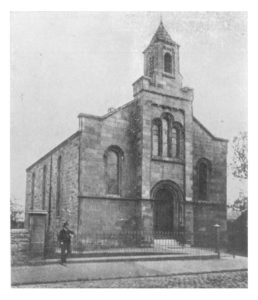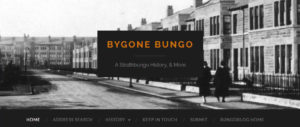The Strathbungo Society agreed last year to affiliated to the Alexander Thomson Society and, for those who are interested, there is lots of information in their New Year message about what they do. “The renowned architect Alexander “Greek” Thomson designed 1-10 (Moray Place), and lived at No 1. He did not design any further buildings in Moray Place or the Squares, however, although the Titwood Place and Salisbury Quadrant tenements in Nithsdale Road and Nithsdale Drive were probably built to his design.” (http://bygone.bungoblog.com)
Category: Architecture (Page 2 of 3)
Sorry folks, failed to get report of the fourth discussion group at AGM out for last week (see Heather’s post 27th). This group discussed how we might progress the ideas that came out of the Pollokshields charrette or community planning event, subsequent walkabouts for the Nithsdale Rd area (which includes the phone box) and the stall we ran at Bungo in the Back Lanes. Since then very little has happened but recently we were informed by the Pollokshields Trust that it has been approved funding in principle to help the local community develop proposals further – good news.
While it was acknowledged that numerous good ideas for improving the area had been collected, the unanimous view was we should develop proposals to redesign the Nithsdale Rd deadend as a whole, with a view to greening it and changing the road layout. It was felt there was huge potential to improve the street from how it is at present to the benefit of the people who live there, local businesses and the wider local community. The big idea here was there should be a line of trees down the centre (could be in planters) with parking on either side of this central line around which cars could circulate. Coupled with this the pavement areas could be improved (eg removal of rubbish bins).
There was support for setting up a steering group to take this forward, with their first task being to consult and involve local residents and businesses in making the street a better place – with support hopefully from the Pollokshields Trust. While this could include some smaller projects – some “quick wins” (the phonebox?) would encourage people to get involved – central to this should developing proposals for street redesign.
And two new ideas were suggested, a city tree (see here) to reduce the pollution from Pollokshaws Rd and subterranean rubbish bins as happens in many parts of Europe.
If you are interested in getting involved contact treasurer@strathbungo.co.uk
Ever wondered about the history of the area where you live, or who lived in your house before you?
Well now you can, at our sister website, Bygone Bungo.
We aim to collect together all those interested in local history, and compile a more complete record of the history and development of Strathbungo and the surrounding area.
As the site expands, we will add documents about various aspects of local history, original sources, and photographs.
We are also compiling a database of local properties, who built them, when, and who lived there subsequently. We already know of Greek Thomson and Rennie Mackintosh, but there were also other architects, military men & footballers (and one who was all three!), ministers, doctors, and a secret service agent. We would be particularly interested in those who still have the deeds for their properties, who know of notable former residents, or have any old photos of the area. The database is live – you can now see who lived in your house before you! Just select Address Search or People Search, and start exploring. There are currently some 5000 individuals listed, mostly from 1865 to 1925.
If you are interested in contributing, please get in touch. We are looking for those with suggestions for research, or wanting help with their own projects, those with stories to tell, with old deeds to local properties, or those willing to help transcribe old records.
To keep track of developments, you can also follow us on Facebook.

The Strathbungo Society has been seeking to positively influence our biggest neighbour – Network Rail – for the past two years. One issue has caused unnecessary uncertainty: what are the legal and ‘established’ boundaries along Moray Place? Network Rail didn’t seem to know, nor did we.
So the Society’s Andrew Downie decided to do some research, looking at the original feu disposition between the original landowner and railway company as well as information from residents’ title deeds.
His resulting report is the definitive guide to the legal and ‘established’ boundaries that have developed along Moray Place over the past 100 years or so. Andrew’s report has been shared with Network Rail who accept it in full. The report has aided the Society’s discussions with Network Rail as to where it can – and cannot – place any new fence.
It’s not the answer to everything about Network Rail’s proposed fence, but it has certainly shed much-needed light on the where the legal and established boundaries lie. If you want to read it yourself, please do – click on the link below.
The Railway Boundary at Moray Place (.pdf, 817 kb)
In mid-August pavements on Nithsdale Street and Road were resurfaced with black tarmac. This was done to a very poor standard and seems to have no account of the Council’s policies for Conservation Areas. As a result the Strathbungo Society Committee wrote to the Council to express our concerns, state that we thought this was a lost opportunity to improve the local streetscape and to ask for a way forward (the letter is pasted below). The Council has now agreed to a site meeting on Thursday 25th September to look at the standard of the work undertaken and discuss the issues that we have raised. We will post an update following this meeting.
Meantime the Society has contacted a number of local residents who we know have expertise in architecture or planning conservation who may be able to give examples of good practice we could cite at the meeting. If you think you could contribute to this please contact me at nickkempe@tinyworld.co.uk
Plans for a new urban skate park at the M74 flyover at Port Eglington have been unveiled for a currently empty site adjacent to the main route from Strathbungo (and points south) to Glasgow city centre. Drawing on inspiration from cities across the globe, including from Portland Oregon where skateboarders identified and built their own skate park, the projects promoters’ aim is to develop a new urban park for Glasgow to attract not only skateboarders, BMX bikers but wider local communities, including Strathbungo.
http://www.bbc.co.uk/news/uk-scotland-glasgow-west-28309787
http://www.eveningtimes.co.uk/news/1m-plan-to-turn-flyover-site-into-new-skatepark-171196n.24759357
Plans for the £1m park have had funding support from Pollokshields Partnership (on which the Strathbungo Society sits), Transport Scotland, which owns the site, and Creative Scotland.
An exhibition of the plans will be at the Lighthouse from Saturday 19 July to 10 August 2014. For more information, see: http://www.thelighthouse.co.uk/visit/exhibition/gusm74
 You were asked to identify the Strathbungo building below, and its location.
You were asked to identify the Strathbungo building below, and its location.
 Now the newsletter is out, I can reveal this was the first Strathbungo Parish Church, built in 1839, but demolished sometime after 1883. The photo dates from around 1879.
Now the newsletter is out, I can reveal this was the first Strathbungo Parish Church, built in 1839, but demolished sometime after 1883. The photo dates from around 1879.
The second church was built on the same site, reusing much of the stone, in 1887-88. The facade of the second church still stands on Pollokshaws Road, even though the rest of the church was demolished in 2006. The facade was incorporated into the modern flats. The current view from the same spot is shown on the right.
You can read more about Strathbungo’s church in the newsletter, when it drops through your door, or by downloading it from this blog.
I have added a painting of the old Strathbungo village in the 1820′s to the http://www.scotcities.com/cathcart/strathbungo_crossmyloof.htm web page.
Many thanks to Donald Watson for letting me know about it.
The painting is intriguing because the artist used two different positions to capture the final scene.
The foreground view is looking north-west from a spot near the entrance to Queens Park at Balvicar Drive.
The background panoramic view of the city is looking north-east from the summit of Camphill, near the present day Queen’s Park flagpole.
In his first position, the artist was looking over the village of Strathbungo (or Marchtown), seeing the same buildings shown in the old maps, with the tall chimney of the Titwood Brick and Tile Works in the centre of the picture, and the original church at the edge of the village to the right.
Here is a composite image of the 1820 painting overlaid with 2013 photographs taken from the top and bottom of the hill.
The photographs matched the painting almost perfectly, even after a period of 190 years!
You’ll recognise the viewpoints of the two photographs, the next time you’re in the park.
Any more contributions, suggestions or corrections to the http://www.scotcities.com/cathcart/strathbungo_crossmyloof.htm web page would be be very welcome.
There is now a Strathbungo & Crossmyloof section of my urban exploration website with lots of old and new images illustrating the origins and history of Strathbungo.
© 2024 The Strathbungo Society
Theme by Anders Norén — Up ↑









Recent Comments